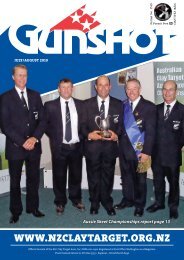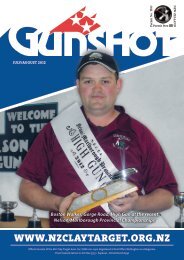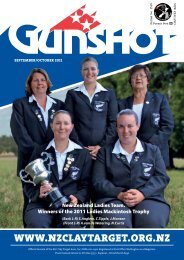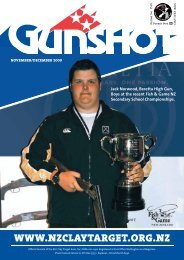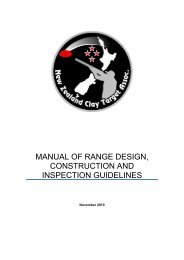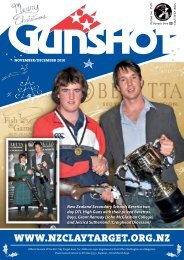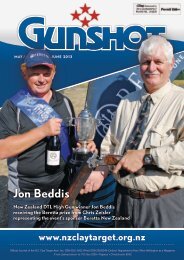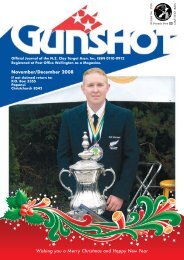March/April 2009 - New Zealand Clay Target Association
March/April 2009 - New Zealand Clay Target Association
March/April 2009 - New Zealand Clay Target Association
You also want an ePaper? Increase the reach of your titles
YUMPU automatically turns print PDFs into web optimized ePapers that Google loves.
use of the forend hand to move the gun,<br />
and that resulted in lost targets.<br />
The ‘understanding’<br />
aspect to good scores<br />
It seems that all trapshooters, no<br />
matter what class they happen to be<br />
in, will have their good days and their<br />
bad days. It just stands to reason that<br />
shooters in the lower classes seem to<br />
have more bad days than those in the<br />
higher classes. While scores may be<br />
relative depending on our class, we are<br />
all able to recognise a bad day or a bad<br />
score when we experience one. What<br />
is more difficult in these situations is<br />
recognising the reasons for bad days or<br />
bad scores and turning them into great<br />
days.<br />
One of the reasons for fewer bad days or<br />
bad scores among AAA shooters is that<br />
they are usually more experienced and<br />
far more consistent in doing what they<br />
need to do to break more targets. It is<br />
that level to strive for, and sometimes<br />
all it takes is time, understanding and<br />
practice. The purpose of this column is<br />
to offer a bit more on the “understanding”<br />
aspect of shooting good scores.<br />
Even great shooters will sometimes<br />
develop a bad habit. They may forget<br />
a simple fundamental or just fall into<br />
a habit that costs them an occasional<br />
target. The problem is, in their class, an<br />
occasional target is enough to lose the<br />
race. I was recently fortunate enough<br />
to watch a great shooter hammering<br />
handicap targets with ease. I was<br />
impressed with his shooting until I saw<br />
him miss a couple of targets because of<br />
a fundamental error. I like to use names<br />
(but never the actual name) of shooters<br />
that I have observed and write about,<br />
so I’ll just call him Smitty, a common<br />
name that could be anyone.<br />
While I was watching Smitty hammering<br />
his targets, I noticed that at times he<br />
failed to shift a bit of his weight to his<br />
front foot. I also noted that every time<br />
he missed a target, he hadn’t shifted his<br />
weight. When he missed a target on Post<br />
1, he used his forend arm to move the<br />
gun toward the target. It was apparent<br />
that Smitty had lost track of this simple<br />
fundamental, and it was costing him<br />
targets.<br />
Whenever you mount the gun prior to<br />
calling for your target, you should shift<br />
a bit of weight to the front leg. For a<br />
right-handed shooter, this is the left<br />
leg; it’s the right leg for a left-handed<br />
shooter. This sound simple enough,<br />
but you also need to understand the<br />
reason for shifting the weight. To begin<br />
with, the feet should be positioned at<br />
shoulder width and comfortable. The<br />
weight shift should be just enough<br />
to have more than 50% of the body’s<br />
weight on that front leg. This will<br />
result in the shooter’s head being over<br />
the front leg. Now when the shooter<br />
mounts the gun and shifts the weight,<br />
he will form a straight line of pivot over<br />
the front foot. He can now lock the gun<br />
into place, and when he calls for his<br />
target, he will pivot to the target. He<br />
will not move the gun with the forend<br />
arm; he will only support the gun with<br />
the forend arm. The gun will be moved<br />
to the target using the pivot.<br />
If a shooter fails to pivot to the target,<br />
Sometimes all it<br />
takes is time,<br />
understanding and<br />
practice.<br />
he will likely find it necessary to use<br />
the forend arm to move the gun to the<br />
target. This could create a situation<br />
where the shot looked pretty good, but<br />
the result was a lost target. The reason<br />
for this is that the shooter’s mount fell<br />
apart when he used the forend arm to<br />
move the gun, and this can change the<br />
point of impact. Some targets will still<br />
be broken when a shooter makes this<br />
fundamental error, but as trapshooters,<br />
we are not after some of the targets –<br />
we’re after all of them. When Smitty<br />
failed to shift his weight forward, he<br />
approached the target flat-footed and<br />
did not pivot his entire upper body<br />
toward the target. This resulted in his<br />
When the weight is shifted to the front<br />
leg and the shooter uses a pivot to<br />
move to the target, he will also find that<br />
he is able to approach the target from<br />
the bottom and have a great view of the<br />
target all the way to the shot. As he<br />
pivots, the gun will automatically come<br />
to the target without the need to lift the<br />
gun up to the target with the forend<br />
hand. If the gun needs to come up,<br />
the pivot will allow it to happen. It will<br />
feel like your moves, especially to angle<br />
targets, are mostly horizontal. This<br />
method does not require the shooter to<br />
hold an exceptionally high gun, but he<br />
should be holding above the traphouse<br />
prior to his call for the target. If a<br />
shooter stands flat-footed – or worse<br />
yet, lets his weight shift to his back<br />
leg – the tendency will be force the gun<br />
to loop toward the target with an arc,<br />
and many times the shooter will lose<br />
sight of the target just as he is about<br />
to shoot.<br />
A left-handed shooter is more likely to<br />
shift his weight to the back foot when<br />
he is standing on posts 1 or 2, while<br />
a right-handed shooter will have this<br />
tendency on posts 4 and 5. The next<br />
time you get the opportunity, with<br />
an empty gun, stand on one of these<br />
posts and simulate your move to a<br />
hard right or left angle while allowing<br />
your weight to rock to your back leg.<br />
You will probably notice that the gun<br />
rises as you make this move and has<br />
a tendency to arc toward the target,<br />
and make it more difficult to see. Now<br />
maintain your weight on the front leg<br />
and pivot toward the simulated target.<br />
You will probably notice that you can<br />
approach the target from the bottom<br />
without the gun looping in an upward<br />
arc. This technique will allow Smitty<br />
and all other shooters a better view of<br />
the target without the clutter of the gun<br />
hiding it. The better you see the target,<br />
the better you will break it.<br />
In order for the pivot to work for you,<br />
good foot positions on each post will be<br />
required. You will want to avoid having<br />
your back turned to the angles, so on<br />
Post 1, a shooter should stand facing<br />
those angles, which will be all left angles.<br />
As you move to each subsequent post,<br />
you will move your stance slightly to<br />
the right progressively. This applies to<br />
both right- and left-handed shooters.<br />
When you arrive on Post 5, you will<br />
again be facing the angle targets, which<br />
are now all right angles. If your stance<br />
doesn’t allow you to pivot toward your<br />
angle targets, adjust it before you end<br />
up using the forend arm to move to<br />
the target. You should feel smooth<br />
Gunshot 25



